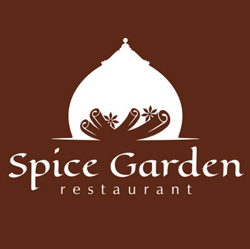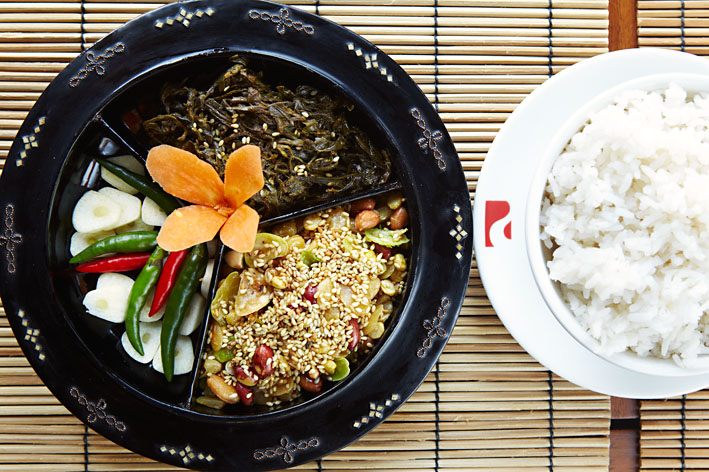Burmese cuisine is actually the cuisine of Myanmar, as this is the name of the former Burma. It has gathered, in time, influences from India, China and Thailand. It must be noted that the Burmese only used concepts from these cuisines for inspiration. They have traditional cooking methods and dishes of their own. Hence, Myanmar cuisine has its own identity. It includes dishes from various regions of Myanmar. The diversity of Myanmar’s cuisine has also been contributed to by the myriad local ethnic minorities. The Myanmar are the most dominant group, but other groups including the Chin people also have distinct cuisines.
A traditional Myanmar meal includes a bowl of soup, rice, several meat curries, and ngapi yay with tozaya (vegetables for dipping).A traditional meal is served with rice and tea. Breakfast is generally eaten between 6:30am and 7:30am and often consists of rice or soup. Lunch is generally eaten between 12:00noon and 1:00pm. Many people eat out, grabbing a quick meal or snack such as a bowl of noodles or curry and rice. Dinner is generally eaten between 6:00pm and 7:00pm.
The Myanmar people eat with their right hand, forming the rice into a small bowl with only the fingertips and mixing this with various morsels before popping it into their mouths. Knives and forks are used rarely in homes but will always be provided for guests and are available in restaurants and hotels. Drinks are not often served with the meal and, instead, the usual liquid accompaniment is in the form of a light broth or consommé served from a communal bowl. Outside of the meal, the Burmese beverage of choice is light green tea, yay nway gyan).

The most common starch and staple food in Myanmar is white rice (htamin), which is served with accompanying meat dishes called hin . Paw hsan hmwe, fragrant aroma rice is the most popular rice used in Burma and is rated as high as the Thai fragrant rice or Basmati rice. Glutinous rice, called kauk hnyin (from Shan State) is also very popular. A popular variety known as nga cheik,is commonly a breakfast dish. Myanmar dishes are not cooked with precise recipes. The use and portion of ingredients used may vary, but the precision of timing is of utmost importance. One of the few remaining pre-colonial cookbooks is the “Sadawset Kyan,” (lit. Treatise on Royal Foods), written on palm leaves in 1866 during the Konbaung dynasty.
In traditional Burmese medicine, foods are divided into two classes: heating (apu za) or cooling (a-aye za), based on their effects on one’s body system, similar to the Chinese classification of food. Examples of heating foods include: chicken, bitter melon, durian, mango, chocolate, ice cream. Cooling foods:, pork, eggplant, dairy products, cucumbers, radish. The Burmese also hold several taboos and superstitions regarding consumption during various occasions in one’s life, especially pregnancy. For instance, pregnant women are not supposed to eat chili (for the belief that it causes children to have sparse scalp hairs).
Ingredients used in Myanmar dishes are often fresh. Many fruits are used in conjunction with vegetables in many dishes. Myanmar people eat a great variety of vegetables and fruits, and all kinds of meat. A very popular vegetable is the danyin thi, which is usually boiled or roasted and dipped in salt, oil and sometimes, cooked coconut fat. Myanmar cuisine is full of condiments, from sweet, sour to savoury. The most popular are pickled mango, balachaung (shrimp and ngapi floss) and ngapi gyaw (fried ngapi) and preserved vegetables in rice wine (from Shan State).
Ngapi plays a major part in condiments, as a dip for fresh vegetables. Ngapi a paste made from salted, fermented fish or shrimp, is considered the cornerstone of any Burmese traditional meal. It is used as a main ingredient in soup base, salads, main dishes, condiments, and plainly with cooked rice as well. Different usage for various dish depends on the region. Fermented beans, called pè ngapi, from the Shan State plays a major role in Shan cuisine. Dried bean ngapi chips are used as condiments for various Shan dishes.

Another bean based condiment popular amongst the Bamar and the central dry region is Pone Yay Gyi – a thick salty black paste made from fermented soy beans. It is used in cooking, especially pork, and as a salad, with ground nut oil, chopped onions and red chili. Pagan is an important producer of Pone Yay Gyi. Magyi-thee daung (Pounded tamarind), Zeebjuthee daung (Pounded myrobalam), Ngayoke thee daung (Pounded chili) are very popular dips and sauces in Myanmar.
Myanmar food consists largely of oil-based curries, salads with fresh or boiled vegetables, various types of salted fish recipes and soups, all of which are eaten with rice. Herbs are nearly always used, the common ones being ginger, turmeric, garlic, chilli, lemon grass, spring onion and coriander. Myanmar food is best sampled in homes. The main dish features pork, beef, mutton, chicken, duck, fish or prawn, eggs cooked in onions, and a gravy that is based on garlic, ginger, saffron powder, shrimp sauce or soy sauce, salt and a little bit of chili powder. The meat can be fried, stewed, steamed or roasted. Side dishes are usually a salad or fried vegetables.
Traditional dishes have many versions around the country. One of the most famous is “Mohinga”, thin or flat rice noodles eaten with a fish-based soup. Other versions have different types of soups. A bean powder sauce or soup is often used in areas where good freshwater fish cannot be obtained easily and beans and pulses are abundant. This dish is the favorite of all Myanmar people and they especially love to eat it early in the morning before going to work. When served piping hot with fresh crisps and sprinkled with chopped coriander, the smell really is enough to make your mouth water.
“Mohinga” is also served to monks and guests at feasts as it is a neat one-dish meal. It is cooked in large pots in the monastery grounds or at home by family and relatives, all of whom are expected to help out at feasts, if only to pour out plain tea for the helpers. Another traditional dish which is often served at feasts and celebrations is “Ohno-Khauk-Swe”. This consists of Chinese style yellow noodles and is eaten with chicken in a coconut-based sauce. It is very rich and filling and if eaten too often it tends to cause headaches, indigestion and high blood pressure as the coconut base is full of oil. Sometimes evaporated milk can be substituted. The Thais in Chaing Mai, close to the Myanmar border, make a similar dish called “Khow Swoy”.
As in all countries, each region has its specialties and food traditions. Mandalay is famous for its “Mee-Shay”, rice noodles which are mixed with pickled tofu, pork or chicken and preserved mustard. Pyin Oo Lwin specialises in a tofu salad; the Shan state has a dish called ” Shan Sour Rice”; and Mawlamyine its durian and mango preserves. Due to its abundance of pineapples, Dawei has pineapple rice, while Dry Zone’s toddy palm is used to make a sugar called “Jaggery ” and an alcoholic wine called “Toddy”.

As for snacks, common ones include glutinous rice cakes wrapped in banana leaves and steamed; fritters of various vegetables; and “Lepet” ,tea leaves marinated in oil with dried shrimps, garlic and sesame seeds. All Myanmar snacks are made of rice or sticky rice powder. Some snacks of rice powder are mixed with jaggery and baked, steamed or fried.Bain mont is baked creamy rice powder mixing with jaggery liquid. Sliced peanuts, coconut and poppy seeds are spread over it during baking. It looks like a pan cake and the taste is sweet. Mont sein baung is steamed creamy rice-powder with jaggery liquid. It includes two layers: the upper white one is just steamed creamy rice-powder; the lower brown part is steamed rice powder mixed with liquid jaggery. Thin sliced coconut and pounded sesame seeds are added when served.
Myanmar dining tables are round and low. Family members sit on the mats around the table when eating. Food is not served in courses. Dishes are served simultaneously with different items are spread out on the table, and people help themselves and put food on their plates. Myanmar food tables are usually small and rounded. The atmosphere desired is not one of elegance or polish. What is desired is convivial closeness of those who gather to eat. Dishes should be small but deep, unlike the large serving dishes of the West. For relishes, pickles and dips Burmese use 3-4 inch diameter bowls. For normal curries, fried vegetables and salads they use 5-7 inch diameter bowls. Suitable serving spoons of metal or even Chinaware are put into curries and bowls.
When eating, it is customary for the elderly to be served first and coughing, sneezing or blowing one’s nose at table is not acceptable. Politely excuse yourself if you feel the need. Also do not use tooth-picks without covering with your mouth with your hand or sit at the head of the table unless you are eldest person there. Out of respect, the eldest diners are always served first before the rest join in; even when the elders are absent, the first morsel of rice from the pot is scooped and put aside as an act of respect to one’s parents, a custom known as u cha (lit. first serve).
Hospitality is often based on providing food and often the more people that come the better, with reason of course. Printed invitations are uncommon except for ceremonies at monasteries and for weddings. Locals usually go around and invite close friends, relatives and whoever they want to invite verbally. Since most Burmese are Buddhists many ceremonies are held at monasteries called Ahlu. These events are regarded as “a joyful and peaceful type of donation.” Many curries and rice and served. Nowadays, Western style parties are held at hotels.








